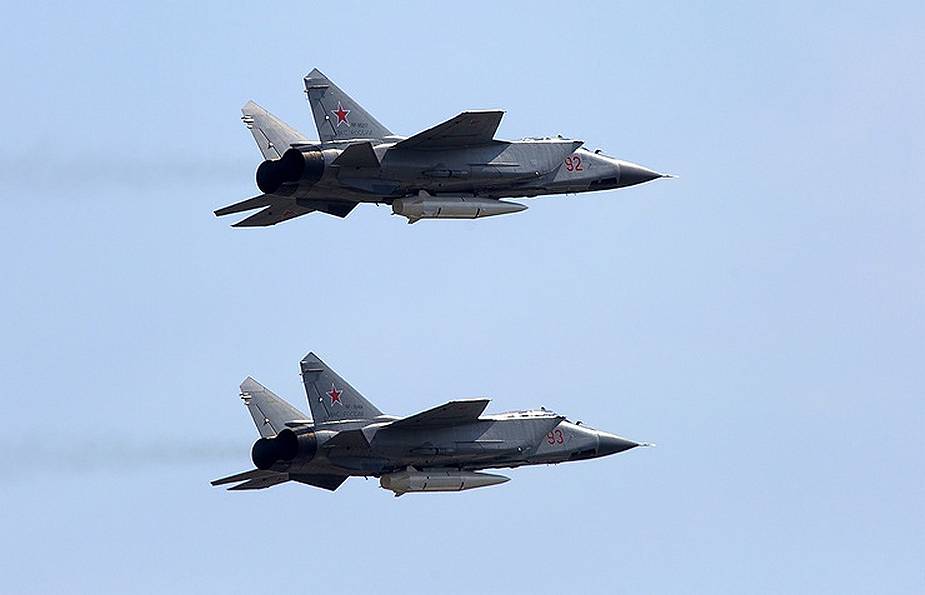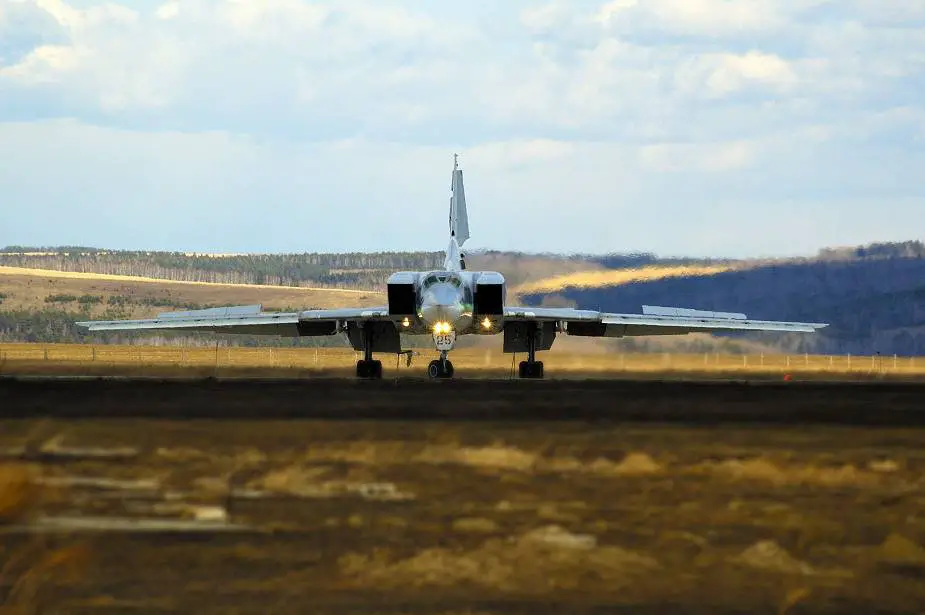- Army
- Conflicts in the world
- Israel - Iran conflict 2025
- Pakistan - India Conflict 2025
- Russia Ukraine War 2022
- Libya conflict day by day
- HAMAS - Israel War 2023
- Operation Serval in Mali French Army
- Sangaris operation Central African Republic
- Sangaris opération militaire République Centreafrique
- Ukraine - Russia conflict
- Syria conflict news
- Defence & Security Industry Technology
- Armies in the world
- Analysis Defense and Security Industry
- Conflicts in the world
- Navy
- Air
Russia uses Kinzhal hypersonic missile to destroy ammunition depot in Ukraine
According to information published by the Russian press agency RIA Novosti on March 18, 2022, Russian armed forces have used for the first time Kinzhal hypersonic missile launched from an aircraft to destroy a Ukrainian military depot of ammunition in the village of Deliatyn in the Ivano-Frankivsk region, located about 100 km from the border with Romania.
Follow Army Recognition on Google News at this link

Russian MiG-31 fighter jets armed with Kinzhal (Dagger) hypersonic missile. (Archive picture source TASS)
What is a Hypersonic Missile?
A hypersonic missile can fly at a speed of Mach 5 (five times the speed of sound) while maneuvering in the atmosphere. Unlike ballistic missiles, hypersonic weapons do not follow a ballistic trajectory and can maneuver en route to their destination.
One of the advantages of the hypersonic missile is its ability to challenge detection and defense due to its speed, maneuverability, and low altitude of the flight. For example, terrestrial-based radar cannot detect hypersonic weapons until late in the weapon’s flight. This delayed detection compresses the timeline for decision-makers assessing their response options and for a defensive system to intercept the attacking weapon and potentially permitting only a single intercept attempt.
The Kinzhal Kh-47M2 also nicknamed Dagger is a Russian nuclear-capable air-to-ground hypersonic missile that can be launched from Tu-22M3 bomber or MiG-31K fighter aircraft. The development of the Kinzhal ballistic missile was based on the Russian-made ground-launched Iskander-M short-range nuclear-capable ballistic missile using a solid-propellant rocket with small fins for maneuverability. The missile was successfully tested in July 2018 launched from a modified MiG-31 fighter, according to US intelligence reports.
Russian military source has reported the Kinzhal can reach a top speed of Mach 10, with a range of up to 1,200 miles (around 2,000 km) when launched from the MiG-31. The Kinzhal is reportedly capable of maneuverable flight, as well as of striking both ground and naval targets, and could eventually be fitted with a nuclear warhead.
The MiG-31K is a modified version of the Russian-made MiG-31 supersonic interceptor aircraft, NATO code designation Foxhound. The aircraft has been modified to carry one Kinzhal hypersonic missile. The missile is launched from an altitude of 18 km at supersonic speeds. The missile is released and falls probably tens of meters, ejects a rocket cap that is used to protect the rocket motor during the jet flight, and then uses its solid rocket motors to accelerate to hypersonic velocity.
The Tu-22М3 long-range supersonic missile carrier bomber (NATO code designation Backfire) is designed to destroy sea- and ground-based targets by means of guided missiles and aerial bombs.
In 2018, the first completely modernized Tu-22М3М missile carrier bomber was created within the framework of a large-scale modernization program for aircraft systems of strategic and long-range aviation. In the course of the complete modernization, the aircraft was equipped with an advanced digital avionics system based on domestic components. The conducted works resulted in the considerable enhancement of combat capabilities of the aircraft system including increased tactical effectiveness and larger operational radius. The first flight of the completely modernized Tu-22М3М missile carrier bomber was on December 28, 2018.

Russian-made Tu-22M3 bomber aircraft (Picture source Tupolev)
TASS news published on March 22, 13:30. Army Recognition quotes the original text.
Russia for the first time live fires Kinzhal missile in Ukraine
ANALYSIS: KINZHAL-MISSILE
MOSCOW, March 22. /TASS-DEFENSE/. Russia for the first time live fired Kinzhal (Dagger) hypersonic missiles on March 18 and 19 to destroy Ukrainian military infrastructure.
The Defense Ministry said the first Kinzhal targeted one of the four Soviet-era underground arms depots in western Ukraine known as Object 711 or Ivano-Frankovsk-16. The depot for nuclear weapons was launched in 1955. It kept and serviced the warheads of strategic, tactical and intercontinental missiles, which were on duty from Moldavia to the Black Sea. The depot was located deep underground in the mountains and was thus protected against nuclear weapons.
“On March 18, Kinzhal airborne complex with aero-ballistic missiles destroyed as major underground arms and munitions depot of the Ukrainian army in Delyatin settlement of Ivano-Frankovsk region,” Russian Defense Ministry Spokesman Igor Konashenkov said. It was the first report of the ministry about combat engagement of Kinzhal.
The second Kinzhal strike was reported on March 20. The missile destroyed a fuel depot of the Ukrainian army in Konstantinovka settlement in Nikolaev region. Konashenkov said the depot supplied fuel to Ukrainian army operating in the south of the country.
He described the strike as efficient. The hypersonic missile flew a thousand kilometers in less than ten minutes. “The combat use of Kinzhal airborne missile has confirmed its effectiveness in destroying highly protected targets. Strikes by this missile at military infrastructure facilities of Ukraine during the special military operation will continue,” the spokesman said.
Kinzhal carried a conventional warhead. The missile can carry a nuclear warhead.
Test launches
Kinzhal was test fired three times. The first test took place in the Mediterranean Sea in June 2021. MiG-31K fighter jets that carry the hypersonic missile flew in the Eastern Mediterranean in the company of Su-35 and Su-34 jets.
Kinzhal was tested for the second time on February 15, 2022 at a joint exercise with the Russian Navy in the Mediterranean Sea. MiG-31K trained together with warships of the Northern, Pacific and Black Sea fleets to destroy a hostile naval force.
The third test was conducted at the exercise of the Russian strategic deterrence forces on February 19, 2022. The Defense Ministry released a video showing the destruction of the target.
It was reported in January that the first regiment of MiG-31K with Kinzhal was created in the long-range aviation.
European, US reaction
US Secretary of Defense Lloyd Austin said he did not believe that the Russian engagement of hypersonic missiles would radically change the existing situation.
However, a representative of the German Defense Ministry expressed concern. “We are concerned by the first engagement by Russia of a hypersonic missile against Ukraine,” she said.
Russian experts
Head of the Military-political analysis bureau Alexander Mikhailov believes the capabilities of Kinzhal demonstrated in Ukraine confirm the Russian leadership in hypersonic weapons.
“The use of hypersonic weapons in the special military operation is justified, as the Ukrainian army still has long-range air defense systems. It is logical to engage precision weapons that guarantee destruction without any chance to intercept them,” he told TASS.
The demonstration of the missile launches is necessary to counter the biased western criticism of Russian arms, Mikhailov believes. “It is anyway necessary to demonstrate the latest Russian arms, including Kinzhal,” he said.
Editor-in-Chief of the Independent Military Review Dmitry Litovkin said the engagement of Kinzhal was highly efficient. “Kinzhal is an analogue of the operational-tactical Iskander missile complex. It was impossible to deliver the launcher to the proper place although its range is 500 km,” he said.
Litovkin believes there still may be major groups of Ukrainian nationalists who could bar the deployment of Iskander. “The Russian Aerospace Forces can reach any point in Europe. Operational and tactical aviation is engaged. The missile carried by (MiG-31K) fighter jet has a strategic status,” he said adding the hypersonic missiles can be armed with nuclear warheads.
“Kinzhal is a serious, sophisticated and very dangerous weapon,” Litovkin said.
Kinzhal
President Vladimir Putin for the first time announced the creation of Kinzhal in March 1, 2018. He said Russia had created a hypersonic airborne missile unprecedented in the world.
Defense Minister Sergey Shoigu said on December 2021 that Russia had created the first regiment of MiG-31K with Kinzhal missiles.
The hypersonic missile develops Mach 10 speed and has a range of 2000 km. It maneuvers in flight to break through air and missile defense and can carry a conventional or a nuclear warhead.
Military experts believe Kinzhal is armed with a single-stage solid-fuel 9M723 missile of Iskander-M. The range of 2000 km comprises the range of MiG-31K and the missile. The hypersonic speed is developed due to MiG-31, which operates as the first stage and boosts to supersonic speed, and by the engines and trajectory of the missile.
Airborne Kinzhal destroys command posts, air and missile defenses, airbases, aircraft carriers and other important targets. Kinzhal differs from the ground-based Iskander by the tail and smaller steering controls.
End of quote of TASS news.


























